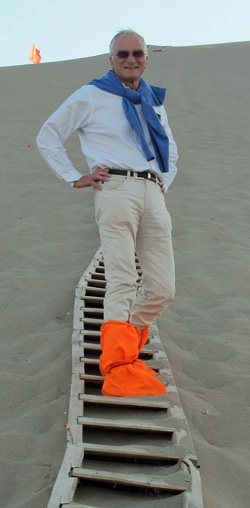About Michael Jura

By Stuart Wolpert/UCLA Newsroom
Professor Michael Jura earned his bachelor's degree in physics from UC Berkeley in 1967 and his Ph.D. in astronomy from Harvard University in 1971, and went on to become a postdoctoral scholar at Princeton University. He joined UCLA's faculty in 1974 as an assistant professor, was promoted in 1977 to associate professor and to full professor in 1981. He continued teaching through the fall quarter of 2015.
Jura started out as a theorist and brought a unique, theory-oriented viewpoint to the analysis of astrophysical data. His research spanned a broad range of topics including intensity fluctuations in pulsars, excitation of molecular hydrogen, star formation and dust in galaxies, the chemical composition of interstellar gas, mass loss from red giant stars, and diffuse interstellar bands. He was especially interested in planetary systems outside the Earth's solar system: their comets, asteroids and planets, as well as determining if there is life outside our solar system.
Among his many contributions to UCLA astronomy and astrophysics, Jura was instrumental in developing the infrared focus of the division when he chaired the department of astronomy in the late 1980s, and he played a central role in hiring many of the astronomy faculty, including Professor Ben Zuckerman, with whom he published research for more than 30 years.
Jura's recent research, on the "pollution" of white dwarf atmospheres, opened a whole new area of research and has allowed the characterization of the chemical composition of small bodies, such as asteroids, in extrasolar planetary systems. His creative approach has provided direct information on extrasolar planetary systems that is very difficult to measure otherwise. By measuring the abundances of elements common to the terrestrial planets, he has been able to infer levels of tectonic activity in these systems, a remarkable feat.
Committed to finding ways to reduce our society's consumption of non-renewable energy, Jura taught courses at UCLA on energy and the environment and strove to move the campus toward increased use of renewable energy. He drove an electric car, and he and his wife installed solar panels on the roof of their home in West Los Angeles.
As Jura wrote on his website, "Our panels provide enough energy both for our house and electric car; the end of gasoline and electricity bills for a lifetime. This home experiment suggests that transition to a sustainable, modern economy is within technical and financial reach. It is most pleasing to have an inexhaustible supply of energy from the sun."
Full UCLA Newsroom article is available here.